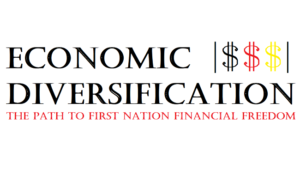Opinion: Economic diversification – A fancy term or a path to financial freedom?
 Submitted by the Anishinabek Nation Economic Development Department
Submitted by the Anishinabek Nation Economic Development DepartmentMore often than not when we hear about economic development initiatives in our communities, we assume that there is some new mine developer that wants to talk about how we all can benefit, or another company wants to access our lands or other resources to benefit us all (but, honestly, mostly them). Although these big companies are integral to our economic development planning, they do not need to be all of the eggs in our basket; we really should be looking to other ways we can diversify our economies and the revenue sources available to our communities and members so that everyone can benefit.
The best way to start the dialogue of economic diversification is to make it part of a community economic development plan. Your community economic development plan should outline how the community as a whole and how each individual community member could benefit from various economic development initiatives. In the first article of this series, we roughly defined economic development; now, we want to home-in on the “building-local-wealth” and “diversifying-the-economy” portion of that definition.
Economic development does not have to focus on major construction, mining, or natural resource projects taking place in your area (but they definitely help). Large companies can assist in diversifying our economies by providing funding and financial resources to the First Nation Government and employment resources, jobs, and income to our community members through Impact Benefit Agreements (IBA). A research publication found in the Library of Parliament states that “IBAs are privately negotiated, legally enforceable agreements that establish formal relationships between Aboriginal communities and industry proponents.” While these mining and larger projects create employment for our community members and support individual wealth – employment income creates a potential revenue source to support and sustain other community initiatives – without a diversified economic plan, there are no mechanisms to retain or redistribute this wealth within our communities.
Diversifying economic development could take the form of programs and processes in a community that foster the development of small businesses; utilize government-funding sources for the creation of community employment; or take the form of user fees or taxes to support community services and government, which in turn provide stable employment to community members.
So for example, say that there is a man – we will call him Jason – that lives in a First Nation that has signed an IBA with a mining company and has not diversified their economic development plan beyond the guaranteed employment clauses contained within the IBA. Jason goes to work and makes $2,000 every week. On payday, he goes to a neighbouring town to get his groceries, do some shopping, get his car fixed, buy a new television, buy a rare John Cougar-Mellencamp record, and save just enough cash to put $40 of gas in his tank from First Nation gas bar. Let’s say that the station owner made a $5 profit from that fill-up, after paying the non-Indigenous-owned fuel company for the delivery. This means from the potential $2,000 that Jason had available to spend in his community only $5 remained in the local First Nation economy.
If there had been a diversified economic development plan in the community that supported local growth and wealth distribution, the scenario could have looked a little different. It could have looked something like this: it’s payday and Jason receives his $2,000 weekly salary, tops up his car at the First Nation gas bar, drops his car off at the mechanic next door to get it fixed, walks one street down to the grocery store to buy groceries, goes across the street to the strip mall to do some shopping, stops by the electronic shop to buy a new television, and saves $40 cash to drive to the neighbouring town to buy a rare John Cougar-Mellencamp record. If our math checks out, we see that $1,960 from the potential $2,000 that Jason had available to spend stayed in his community and only $40 went to supporting the neighbouring town’s economy.
And it doesn’t stop there. Looking at the scenario closer, the grocery store is an independent, First Nation-owned establishment that sells products manufactured by local band members or other First Nation-owned companies. The Band’s Economic Development Corporation operates the strip mall where all of the stores are located and even leases to large corporate retail companies. The gas station and mechanic shop are small businesses that are owned and operated by community members. Moreover, all of these businesses pay property taxes to the community’s Property Tax Corporation, which in turn provides revenues to the Band for the maintenance of community infrastructure that is provided to all of the community. All of this money also creates employment in both the public and private sectors on the First Nation.
The Band’s Economic Development Corporation also owns the building in the neighbouring town that the record store is located in so even some of that revenue makes its way back to the First Nation to support local wealth creation and distribution.
It is easy to see from this simple example that by implementing a diversified community economic development plan – supporting a community-focussed approach to providing programs, services, and distributing wealth – that the leakage of local incomes and revenue sources to other economies is greatly minimized.
If you want to see this type of economic planning in action, look at MillBrook First Nation’s Power Centre in Nova Scotia, or the Osoyoos Indian Band’s Development Corporation in British Columbia. These First Nations’ diversified economic development plans are great examples of how an entire community can work together to support our local economy’s development, success, and independence.


